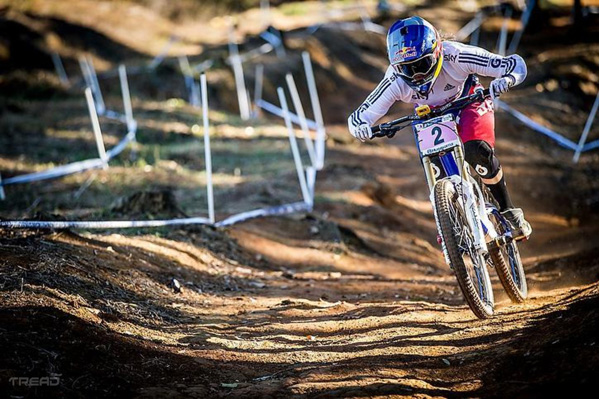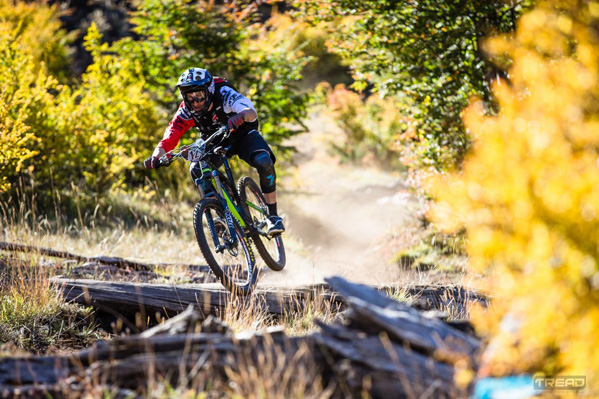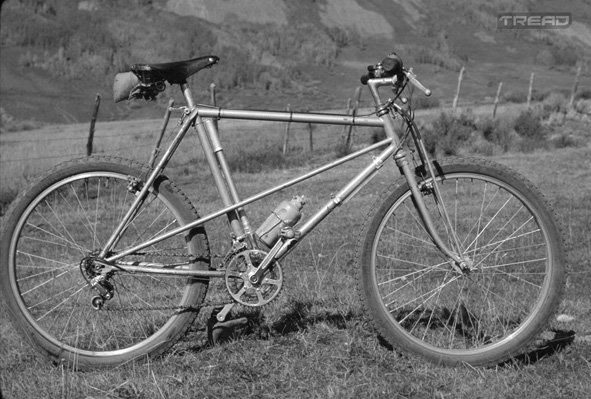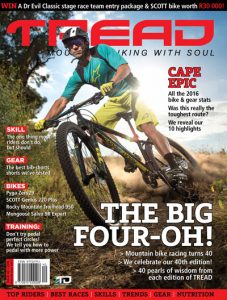On 21 October 1976, the first recorded mountain bike race was held. It was a 2-mile (3.2km) individual time-trial down a gravel road on Mt Tamalpais in Northern California. It was organised by Charlie Kelly and it was ridden by a group of free-spirited fun-loving guys that included Gary Fisher, Joe Breeze and Otis Guy, who were three fastest at the event, which was fondly called Repack. This year marks 40 years since that first mountain bike race. It started with a handful of guys that loved going fast down a gravel road in the bush on beach-cruiser style bikes and it’s now a multi-billion dollar global sport with a number of sub-categories and sub-cultures. Little did those guys know back in 1976 that they were giving birth to the most amazing sport ever? Little did they know that four decades later millions of us would be riding light, reliable, robust bicycles virtually wherever the hell we want to ride them. Here’s a little throwback to those pioneers.
Compiled by Barry McCallum and Sean Badenhorst

EWS star Richie Rude riding in the Alps. Photo: Yeti/Dan Milner
REPACK – WHERE IT ALL BEGAN

Joe Breeze races one of the original Repack events on Breezer #1. Photo: Wende Cragg/San Francisco Museum
“It started innocuously enough,” writes Joe Breeze of the bunch of guys who would gather to throw themselves down a twisty, sketchy fireroad on a mountain in Northern California in the 1970s. While there has been much debate, but little agreement, on who actually invented the mountain bike, there is no doubting the fact that the sport of mountain biking was born around the slopes of Mount Tamalpais, at a race called Repack…
As Charlie Kelly recalls it, the hill got its name sometime after a ride known as the Thanksgiving Appetite Seminar ended on that stretch of road in 1974: “One trip down that hill put years of wear onto a coaster brake (back-pedal hub brake), and if you did not immediately disassemble it and repack all the bearings with grease, the hub would seize up very shortly afterward.”
It became, Breeze writes, a popular, but illicit, downhill thrill for groups of friends for some years, “but whenever you get a bunch of competitive types together, someone is going to claim they are the fastest”. On October 21, 1976, Kelly organised a race to find out just who was.
Set off at two-minute intervals, in a time-trial format, all but one of the 10 riders succumbed to either the deep erosion gullies running down the road, football-sized rocks, the trees lining the route or the off-camber, loosely packed corners. Alan Bonds, according to some, adopted a less reckless approach and stayed upright to claim victory.
Those first Repack racers couldn’t keep that much fun all to themselves, and folk from around the Mount Tam area and beyond started pitching up regularly to line up at the start on a ridge on Pine Mountain and launch themselves into the slight uphill rise before the plunge would begin…
The first downhill would lead to a fast blind left, and into the steepest section of the course. This was said to be an angry mess of ruts and rocks – and a misjudgement could make you airborne and off-line for the next corner, and the series of nervy blind sweeps after that. The fact that it took up to 60 metres to stop the bikes led to landmarks on the course earning monikers like Danger ‘X’, Breeze Tree and the more ominous Vendetti’s Face.
“Out of control, you must make a rapid decision, off the edge, or lay it down,” writes Kelly in his maiden journalistic effort for Bicycling magazine. “Lay it down…damn…torn shirt, bloody elbow…(the shirt was old, so was the elbow).”
After a quick remount, the Repack racer would enter the most spectator-friendly section: a series of fast switchbacks where maximum cornering speeds would be reached.
This on a single-speed coaster would involve throwing the bike into a huge powerslide, in which there would be three contact points with the surface; the two wheels almost parallel to the road, and a trailing foot keeping the rider off the abrasive gravel.
“I’m going way too fast,” gasps cycling historian Frank J Berto, “if I’m going to wipe out, let’s do it in style… Unreal. I didn’t fall… Pedal, pedal, there’s the finish line.”
Breeze is the man who crossed that line the fastest in the most editions of race – 10 – but it was his biggest rival, Gary Fisher, who still holds the fastest time, four minutes 22 seconds down the two-mile (3.2km)-long course.
Equipment failures – snapped forks, broken frames, twisted handlebars, buckled wheels – meant that many riders didn’t make it to the end, and the injuries suffered were ugly. It was a broken arm at a race in ’79 – and a subsequent lawsuit, albeit unsuccessful – which prompted Kelly to call an end to the Repack races.
In 1984 and ’85 Repack was revisited with races sanctioned by the National Off-Road Bicycle Association (Norba), and then a special 20th anniversary edition in 1996.
AND NOW?
Well, now we have a highly organised global sport that’s governed by the International Cycling Union. There are at least six disciplines of highly competitive mountain biking, all of them either having a world series or a world championships, or both…
Cross-country Olympic (XCO):

Photo: Thomas Weschta
Often abbreviated to XC or, at international level, XCO, cross-country races vary in length depending upon the category of rider, usually from around 30 minutes for youth riders to 1.5 to 2 hours for seniors and elites. Races are run on multiple laps of a cross-country course. Cross-country is a mass start race with large fields, often over 100 competitors, so getting a good grid position and a good start is vital. In the race, unlike road racing, riders must be self-sufficient and can only get mechanical assistance in a dedicated technical zone. Again, unlike road racing, large groups seldom form due to the nature of the courses, with riders often battling alone or in small groups of three or four. This is the only mountain bike discipline contested at the Olympic Games.
Cross-country Marathon (XCM):

Team Spur Specialized’s Ariane Kleinhans and Annika Langvad during the final stage (stage 7) of the 2016 Absa Cape Epic Mountain Bike stage race in Durbanville, South Africa on the 20th March 2016<br />
Photo: Ewald Sadie/Cape Epic/SPORTZPICS
Marathon events share much with standard cross-country events but differ in terms of race length. Races often take place on much longer courses than cross-country or use multiple laps of a cross-country style course. There are marathon events for all levels of rider from popular regional and national mass-participation events to UCI ranked world championship level events for elite and top age-group riders. XCM is the most popular form of mountain bike racing in South Africa. The courses here are relatively non-technical in nature and therefore more attractive to a bigger market.
Cross-country Eliminator (XCE):

Photo: Marius Maasewerd / EGO Promotion
A short, explosive and spectator-friendly form of cross-country racing, sharing much with the four-cross racing format. Four riders compete on a short course with races just a few minutes long. Competition begins with qualifying heats before progressing through knockout rounds until only four riders remain for the final.
Four-cross (4X):

World Cup Four-Cross in Thalgau, Austria, 2013. Photo: Lukas Pilz
Four-cross races pit four riders against each other on a steep, technical track. Riders race from a mechanically-controlled, BMX-style starting gate. Events begin with qualifying rounds or motos progressing through knockout stages until the final is reached and an overall winner decided. The format varies depending on the level of competition and number of riders involved.
Downhill (DHI):

Photo: Sven Martin
Downhill races start with practice runs, when riders can learn the course and set-up their bikes for the particular demands of the terrain and the conditions. Practice is followed by a timed run, often used to seed riders for the final, with the fastest rider from the timed run going last, which always builds tension and excitement as leaders are deposed one by one from the ‘hot seat’. This is the discipline that has seen the most South African success, largely via three-time World Champion and three-time World Cup Series Champion, Greg Minnaar.
Enduro:

Originating from France in 2003, the format is based on motorbike enduro and anyone who has followed car rallying should find it instantly familiar. The most basic definition is timed downhills and untimed uphills. Racing is over a series of special stages and whoever has the fastest combined time after those stages wins. Riders need to get between the stages, often for a set start time.
Mountain bike racing by the numbers
The 2015 report wasn’t available at the time of going to print, so we have the stats from the International Cycling Union’s 2014 annual report:
Over the year, 511 events were registered on the UCI International Mountain Bike Calendar, which represented a significant increase on the previous season (422 events).
The number of countries on all five continents hosting events also increased, from 67 to 74.
The number of races registered on the UCI International Mountain Bike Calendar increased considerably in Europe (+ 36) and America (+ 33).
The number of countries registering UCI Elite MTB Teams and UCI MTB Teams also increased in 2014, with new teams from Latvia, Lesotho and New Zealand.
And to think that it all started on 21 October 1976 with a small group of adventurous Californians who wanted to see who get down a 3.2km dirt road descent the fastest…
THE FIRST ‘MOUNTAINBIKE’

Schwinn Excelsior
Cruisers, beaters, bombers, ballooners, fat-tyres… the bikes had different names in the towns dotted around the slopes of Mt Tam. But dump the fenders, the chainguards and any other unnecessary accessories, and you’d have a ‘clunker’.

Breezer #1, the first purpose built mountain bike.
Although many cycling historians say that ‘clunking’ has been around as long as the bicycle has, the Canyon Gang is often credited as putting on the first off-road ‘race’: a free-for all down Mt Tam to Larkspur Canyon to win a baggie of weed.
These early clunker riders used anything they could get their hands on. Anything that broke was simply binned.
One of the members, Marc Vendetti, joined the road racing Velo Club Tamalpais in 1972, and introduced Joe Breeze, Charlie Kelly and Otis Guy to off-road riding. These Marin County roadies set out to modify the clunkers to better their efficiency and performance.
According to Berto, choice components of the period included the Morrow coaster brake for the singlespeeds; and Suntour thumbshifters, TA cranksets and Magura brake levers for geared clunkers.
An important development in the industry, notes Berto, came in 1976 when Alan Bonds sought out the ‘Legendary Wocus’, a bike shop owner who had a ‘mother lode’ of old bikes rusting out back. Working with Gary Fisher and Kelly, he reconditioned the frames and built up clunkers for resale, which ‘helped the Marin mountain bike movement reach a critical mass’.
The sought-after frame at the time was the strong Schwinn Excelsior, but, as Breeze jokes in the movie Klunkerz, “I don’t think the Schwinn designers were thinking about us when they designed those early fat-tyre bikes…”
It was Breeze to whom the first serious riders turned when they wanted a bike specifically designed and built to handle the rigours of racing off-road. In 1977, Kelly approached him to build a light and strong clunker. Breeze agreed and based his bike on the geometry of the Excelsior and welded 10 frames*. These adopted a diamond-style with straight tubing and extra braces running from the top tube to the rear dropouts.
Two years later Kelly became a partner in the business, which would give the sport its name, ‘MountainBikes’, with Fisher, who turned up his nose at Breeze’s frames.
However, when Fisher approached the prolific frame builder Tom Ritchey, he was unaware that he had already been inspired to make his own custom clunker with 26X2.125” wheels after seeing a Breezer. Ritchey opted not to use the lateral braces that were on the Breezer (Breeze too would drop these on later models), and chose thicker material for the downtube to increase strength and rigidity.
The geometry was identical to the Breezer and so the Excelsior geometry remained in the DNA of the off-road bike.
Whereas Breeze had a reputation for being fastidious and methodical, Ritchey was known as the ‘General Motors’ of frame-building. He cranked out quality frames for ‘MountainBikes’ for the next four years, before a fall-out with Fisher, and helped push the industry into the mass market. – Barry McCallum
*All 10 of the original batch of Breezers are still accounted for. No. 1 is displayed at the Smithsonian Institution’s National Museum of American History.
Breezer #1, 1977

This is a ‘Breezer 1’, hand built by Joe Breeze in 1977, this was the first bicycle frame designed specifically for mountain biking. The Breezer 1 was constructed with components that could withstand the repeated pounding of mountain bike riding, such as Araya 26-inch steel rims, Phil Wood hubs, SunTour derailleurs, and Dia-Compe centre-pull brakes. The steel ‘riser’ handlebar and Magura brake levers were repurposed from motorcycles and adapted to work with the Breezer 1’s stem and brake calipers. The large size of the Magura motorcycle levers provided increased braking leverage and was advantageous when trying to ride in wet conditions with slippery steel rims. Other parts, such as the SunTour thumb shifters were adapted from five-speed touring bikes and only came in right hand models. The left side thumb shifter, which controlled the front derailleur, was a right hand shifter that was mounted backwards.
The frame incorporated the geometry of Breeze’s blue 1941 Schwinn Excelsior, the ‘clunker-style’ bike Breeze and others had been using to tackle off-road bicycle riding.
For a lighter, stronger frame, Breeze used straight, chrome-moly steel tubes instead of heavy, curved mild-steel tubing. He added twin laterals from head tube to rear dropouts to stiffen the long frame for better control on corners.
The frame was nickel-plated to handle off-road abuse and had a 597mm top tube, 1130mm wheelbase, 70-degree seattube angle and 68-degree headtube angle.
At a price of $750 complete (at the time, around R900!), each bike came equipped with water bottle and pump, a spare inner tube, tyre levers and spanners.
| Breezer #1 1977 | Yeti SBC 2016 | |
| Frame | Nicke-plated chrome-moly steel | High modulus carbon fibre |
| Suspension | None | Rear: 152mm, Front: 160mm |
| Wheel size | 26-inch | 27.5-inch |
| Wheelbase | 1130mm | 1215mm (Large) |
| Toptube | 597mm | 632mm (Large) |
| Headtube | 68 degrees | 65.5 degrees |
| Seattube | 70 degrees | 73.2 degrees |
| Weight | 15.8kg | 12.8kg (Large) |
Yeti SB6c, 2016

The Yeti SB6c is the bike ridden to the Enduro World Series crown by Richie Rude in 2015. At the time of going to print, he was leading the 2016 rankings. Breeze’s first mountain bikes were built with trail riding enjoyment and performance in mind. Since the Enduro World Series is the pinnacle modern trail-riding performance challenge, we chose the top performing bike to feature here as the current top mountain bike. In the four decades between these two bikes, the world has undergone a significant technological revolution, which has had a significant effect on mountain bike design and materials.
*Originally published in TREAD Issue 40, 2016 – All rights reserved



